So basically, I have a HttpClient that attempts to obtain any form of JSON data from an endpoint. I previously utilized Newtonsoft.Json to achieve this easily but after migrating all of the functions to STJ, I started to notice improper parsing.
Platforms tested: macOS & Linux (Google Kubernetes Engine)
Framework: .NET Core 3.1 LTS
The code screenshots below show an API that returns a JSON Array. I simply stream it, load it into a JsonDocument, and then attempt to peek into it. Nothing comes out as expected. Code below is provided along with the step debug var results.
using System;
using System.ComponentModel;
using System.IO;
using System.Linq;
using System.Net;
using System.Net.Http;
using System.Net.Http.Headers;
using System.Text;
using System.Text.Json;
using System.Threading.Tasks;
using System.Web;
using System.Xml;
namespace HttpCallDemo
{
class Program
{
static async Task Main(string[] args)
{
using (var httpClient = new HttpClient())
{
// FLUSH
httpClient.DefaultRequestHeaders.Clear();
httpClient.MaxResponseContentBufferSize = 4096;
string body = string.Empty, customMediaType = string.Empty; // For POST/PUT
// Setup the url
var uri = new UriBuilder("https://api-pub.bitfinex.com/v2/tickers?symbols=ALL");
uri.Port = -1;
// Pull in the payload
var requestPayload = new HttpRequestMessage(HttpMethod.Get, uri.ToString());
HttpResponseMessage responsePayload;
responsePayload = await httpClient.SendAsync(requestPayload,
HttpCompletionOption.ResponseHeadersRead);
var byteArr = await responsePayload.Content.ReadAsByteArrayAsync();
if (byteArr.LongCount() > 4194304) // 4MB
return; // Too big.
// Pull the content
var contentFromBytes = Encoding.Default.GetString(byteArr);
JsonDocument payload;
switch (responsePayload.StatusCode)
{
case HttpStatusCode.OK:
// Return the payload distinctively
payload = JsonDocument.Parse(contentFromBytes);
#if DEBUG
var testJsonRes = Encoding.UTF8.GetString(
Utf8Json.JsonSerializer.Serialize(payload.RootElement));
// var testRawRes = contentStream.read
var testJsonResEl = payload.RootElement.GetRawText();
#endif
break;
default:
throw new InvalidDataException("Invalid HTTP response.");
}
}
}
}
}
Simply execute the above Minimal code, notice that the payload is different from its original after parsing? I'm sure there's something wrong with the options for STJ. Seems like we have to optimise or explicitly define its limits to allow it to process that JSON payload.
Diving deeper into the debug content made things even weirder. When the HttpClient obtains the payload, reads it to a string, it gives me the entire JSON string as is. However, once we attempt to parse it into a JsonDocument and the further invoking RootElement.Clone(), we'll end up with a JsonElement with much lesser data and while carrying an invalid JSON struct (Below).
ValueKind = Array : "[["tBTCUSD",11418,70.31212518,11419,161.93475693,258.02141213,0.0231,11418,2980.0289306,11438,11003],["tLTCUSD",58.919,2236.00823543,58.95,2884.6718013699997,1.258,0.0218,58.998,63147.48344762,59.261,56.334],["tLTCBTC",0.0051609,962.80334198,0.005166,1170.07399991,-0.000012,-0.0023,0.0051609,4178.13148459,0.0051852,0.0051],["tETHUSD",396.54,336.52151165,396.55,384.37623341,8.26964946,0.0213,396.50930256,69499.5382821,397.77,380.5],["tETHBTC",0.034731,166.67781664000003,0.034751,356.03450125999996,-0.000054,-0.0016,0.034747,5855.04978836,0.035109,0.0343],["tETCBTC",0.00063087,15536.813429530002,0.00063197,16238.600279749999,-0.00000838,-0.0131,0.00063085,73137.62192801,0.00064135,0.00062819],["tETCUSD",7.2059,9527.40221867,7.2176,8805.54677899,0.0517,0.0072,7.2203,49618.78868196,7.2263,7],["tRRTUSD",0.057476,33577.52064154,0.058614,20946.501210000002,0.023114,0.6511,0.058614,210741.23592011,0.06443,0.0355],["tZECUSD",88.131,821.28048322,88.332,880.37484662,5.925,0.0
And of course, attempting to read its contents would result in:
System.InvalidOperationException: Operation is not valid due to the current state of the object.
at System.Text.Json.JsonElement.get_Item(Int32 index)
at Nozomi.Preprocessing.Abstracts.BaseProcessingService`1.ProcessIdentifier(JsonElement jsonDoc, String identifier) in /Users/nicholaschen/Projects/nozomi/Nozomi.Infra.Preprocessing/Abstracts/BaseProcessingService.cs:line 255
Here's proof that there is a proper 38KBs worth of data coming in from the endpoint.
UPDATE
Further testing with this
if (payload.RootElement.ValueKind.Equals(JsonValueKind.Array))
{
string testJsonArr;
testJsonArr = Encoding.UTF8.GetString(
Utf8Json.JsonSerializer.Serialize(
payload.RootElement.EnumerateArray()));
}
show that a larger array of arrays (exceeding 9 elements each with 11 elements) would result in an incomplete JSON struct, causing the issue i'm facing.


